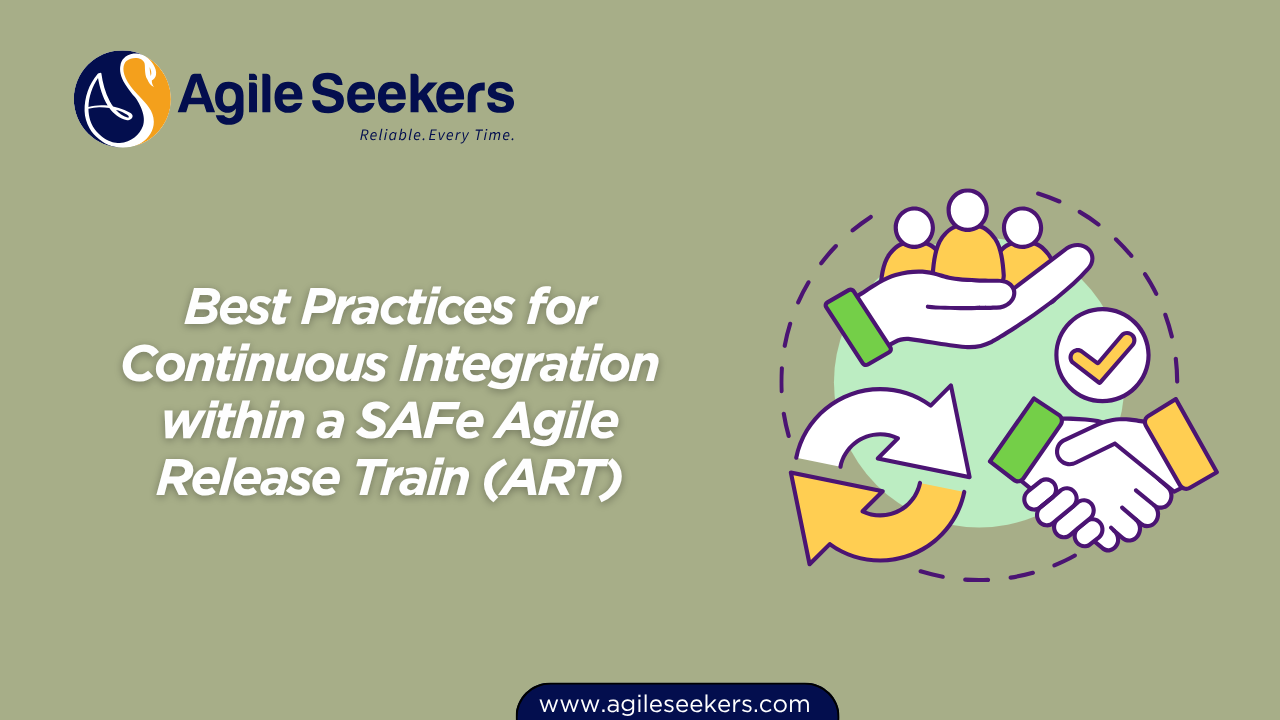Best Practices for Continuous Integration within a SAFe Agile Release Train (ART)

Continuous Integration (CI) is essential within the Scaled Agile Framework (SAFe) to enable Agile Release Trains (ARTs) to deliver value consistently. Effective CI practices streamline software development, enhance product quality, and ensure faster, reliable releases. Let’s explore the most impactful best practices for continuous integration specifically tailored to SAFe environments.
Understanding Continuous Integration within SAFe ARTs
In SAFe, Continuous Integration involves frequently merging code changes into a shared repository. Automated builds and tests verify each integration, identifying issues quickly and enabling teams to resolve conflicts effectively. ARTs, comprising multiple Agile teams working collaboratively, depend heavily on robust CI processes to synchronize development efforts, ensuring continuous alignment and rapid feedback.
Key Best Practices for CI in a SAFe Agile Release Train
Here are the critical best practices for implementing continuous integration within SAFe Agile Release Trains:
1. Maintain a Single Source Repository
Effective CI begins with a single source code repository accessible by all teams within the ART. This centralization simplifies integration, fosters transparency, and prevents version conflicts. Popular tools like GitHub or GitLab are commonly used for managing such repositories.
2. Automate Builds and Tests
Automation is central to successful CI. Automate the build process so that each code commit triggers a new build. Incorporate automated tests—unit tests, integration tests, and regression tests—to ensure rapid and reliable feedback. Tools like Jenkins, GitLab CI, or Azure DevOps are excellent platforms for automating build and testing workflows.
3. Integrate Frequently
Encourage Agile teams to integrate code multiple times daily. Frequent integrations catch conflicts and defects early, making resolution faster and less costly. Teams that adhere to frequent integration experience fewer integration nightmares during system demos and PI planning.
If you're leading Agile transformations, Leading SAFe® certification provides comprehensive insights into encouraging and managing these practices effectively.
4. Establish Robust Version Control Practices
ARTs should adopt clear, robust branching and merging strategies, such as trunk-based development or short-lived feature branches. Short-lived branches facilitate swift merges, minimize conflicts, and support continuous delivery readiness. Maintaining discipline in version control enhances collaboration and reduces errors.
5. Enable Continuous Feedback Loops
CI thrives on immediate feedback. Configure automated notifications and dashboards to inform teams of build statuses and test outcomes. Real-time visibility into the health of integrations motivates swift corrective actions, maintaining the quality of the codebase and alignment with PI objectives.
Effective feedback loops also enhance collaboration between SAFe Scrum Masters and development teams, ensuring impediments are addressed promptly.
6. Maintain Build Stability
Prioritize build stability by immediately addressing failed builds. Implement strict policies: fixing broken builds becomes the highest priority. Stable builds increase team confidence, accelerate development cycles, and ensure smooth system integration during PI iterations.
7. Continuous Improvement through Regular Retrospectives
Regularly schedule ART retrospectives to reflect and refine CI practices. During Inspect and Adapt (I&A) workshops, teams should evaluate the effectiveness of CI processes, identify areas of improvement, and adapt practices accordingly. Continuous improvement ensures CI practices remain relevant and impactful.
Experienced facilitators often benefit from advanced training such as SAFe Advanced Scrum Master certification to refine retrospective effectiveness.
8. Emphasize Automated Infrastructure as Code (IaC)
Leverage Infrastructure as Code to automate environment setup and configuration. IaC ensures consistent, reproducible environments across teams, minimizes manual errors, and significantly speeds up integration and deployment processes. Tools like Terraform, Ansible, and CloudFormation can streamline IaC implementation.
9. Enforce Code Quality Standards
Implement stringent code quality checks within your CI pipeline. Employ static analysis tools (e.g., SonarQube) to identify potential issues early. Enforcing coding standards enhances overall code maintainability and simplifies future integrations, critical for ongoing ART efficiency.
10. Integrate Security into the CI Pipeline (DevSecOps)
Adopt DevSecOps practices by integrating security testing directly into the CI pipeline. Early detection and remediation of vulnerabilities protect ARTs from costly breaches and delays. Tools like OWASP ZAP and Snyk can identify vulnerabilities seamlessly within your CI workflow.
If you're steering product management activities, training like SAFe Product Owner/Product Manager (POPM) certification equips you to prioritize security alongside business value effectively.
11. Foster Cross-Team Collaboration
Encourage consistent communication and collaboration between ART teams. Regular cross-team synchronization meetings, such as ART Sync meetings, help resolve integration dependencies promptly. Collaboration tools like Slack or Microsoft Teams further enhance effective real-time communication.
Professionals leading large ARTs benefit from specialized expertise like the SAFe Release Train Engineer (RTE) certification, emphasizing effective collaboration and ART synchronization strategies.
12. Adopt CI Metrics and Visibility Dashboards
Measure the effectiveness of your CI processes using metrics like build frequency, build success rate, integration cycle times, and test coverage. Visual dashboards using tools like Grafana or Power BI provide ARTs with real-time visibility into these metrics, enabling data-driven decision-making and continuous process improvement.
13. Continuous Training and Coaching
Equip team members with ongoing training and coaching to stay proficient in CI tools, techniques, and best practices. Periodic training sessions ensure teams consistently apply effective CI practices, improving overall ART agility and productivity.
Bringing CI Best Practices to Life
Effectively implementing these continuous integration best practices transforms your ART into a high-performing, agile delivery engine. Teams experience fewer integration issues, enhanced code quality, faster time-to-market, and improved collaboration across the ART.
For teams deeply involved in facilitating SAFe transformations, a strong foundational understanding provided by SAFe Scrum Master Certification proves invaluable in nurturing effective CI cultures within their Agile teams.
Final Thoughts
Adopting best practices for continuous integration within a SAFe Agile Release Train requires commitment, collaboration, and continuous improvement. When implemented thoughtfully, CI not only optimizes ART efficiency but also strengthens product delivery, directly contributing to sustained business success and agility.
Further Assistance:
If you need support refining your CI processes or training your teams effectively in SAFe methodologies, consider reaching out to AgileSeekers:
📞 +91 91 4396 4396
📧 info@agileseekers.com
🌐 www.agileseekers.com
Also read - How to Effectively Decouple Deployment and Release in Your Agile Organization Using SAFe
Also see - Leveraging SAFe’s Continuous Delivery Pipeline to Align Technical Teams and Business Goals




















